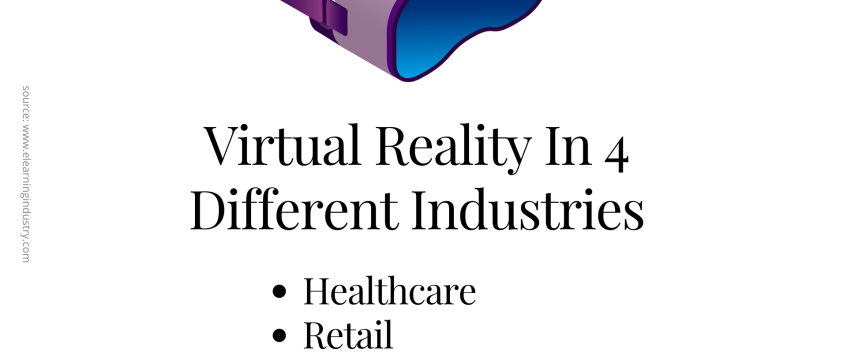-
14
Feb
Using Virtual Reality To Train Employees
Virtual Reality (VR) has taken the world by storm offering new and innovative ways to engage with customers. This success has filtered into businesses as executives realize the potential of this technology to enhance learning and development initiatives for a workforce.
Today’s employees value opportunities to learn in their role. In fact, for the millennial generation, 87% believe that professional development is important in a job while 59% value opportunities to learn and grow and take it into account when choosing to apply to a company.
The increasing availability and decreasing cost of VR presents organizations with the opportunity to stand out from the crowd when it comes to attracting and retaining staff. In this article, we will explore 4 industries using it successfully.
Virtual Reality In 4 Different Industries
1. Healthcare
In the healthcare sector, VR presents huge opportunities. At the first Virtual Reality and Healthcare Symposium earlier this year, technologists and Healthcare specialists came together to explore how VR can and is being used to train healthcare professionals to change lives and heal patients.
In collaboration with Case Western University, Microsoft used HoloLens to develop a training program that will revolutionize the way medical students can understand the anatomy of a body and see how parts relate to each other. The aim of the collaboration is to create a paradigm shift which according to Microsoft will help them prepare the next generation of doctors.
In a hospital setting, VR technology MPathic is being used to teach med students how to break bad news to patients and their families. By using MPathic, students can learn efficient empathetic communication skills and discover how to interpret verbal and nonverbal cues from characters in a scenario, and respond with the most appropriate strategy.
Their responses include displaying facial expressions and emotions with real-time conversations. As a result of the VR training, students who have used MPathic felt more confident having such conversations.
2. Retail
In such a competitive sector it’s key to use all digital technologies to your advantage. In partnership with STRIVR -a company using VR to improve the performance of athletes, brands, and organizations- Walmart is using VR to train its employees in management and customer service.
Using an Oculus Rift headset and gaming PC, staff are trained in 360-degree video-based technology that includes on-screen cues that will prompt staff to make decisions based on real-world situations such as how to deal with Black Friday rush or customer service scenarios.
3. Space
While other industries are now finding uses for VR as a training tool, one of the earliest adopters is NASA. With VR, astronauts are able to train in a way they never could before by practicing to complete tasks in an accurate, zero-G environment.
Specifically, NASA uses VR to train astronauts in the aspect of spacewalking – an action where the astronaut leaves a spaceship environment to perform an action like replacing a faulty module on a spacecraft. However, the problem with spacewalking is astronauts have no idea what to expect until they are actually doing it. By using VR, astronauts can get an idea of what they will experience and reduce the risks of errors.
Another development in NASA’s VR training includes collaborating with Microsoft. The project will utilize HoloLens to simplify communication between astronauts and ground staff. This would mean that astronauts can use this holographic technology for overlaying instructions, doing face-to-face communication, interacting remotely with co-workers, as well as maintaining an inventory.
4. Hospitality
More common industries, like hospitality, are also beginning to venture into VR territory. Take Honeygrow, a fast-casual chain that specializes in stir-fry and salads. Using VR it provides trainees with a tour of a Honeygrow location with the 360-degree view while employees listen to the company’s values from the Founder and CEO of the company.
With 17 locations in Pennsylvania, New Jersey, New York, and Delaware Honeygrow’s plan is to expand into new markets in Boston and Chicago. With so many new employees to both recruit and train in the next few months, the company feels strongly that VR training will do the trick.
By having only one standard orientation and training experience, the aim is that the message will be consistent throughout all stores.
The Benefits Of VR
Before we explore the various industries using VR as a training tool, let’s look at the benefits it can present to staff.
•Mimics real-life situations.
Virtual Reality can be used to create interactive scenarios which mirror real-life situations. This immersive training can include simulating the way equipment responds, imitating the way machinery works, and practicing human actions.
•Complex situations can be simplified.
Complex situations and processes can be recreated through VR allowing employees to practice situations in a simulated environment.
•Makes training enjoyable and entertaining.
With 1 in 3 employees claiming uninspiring content is a barrier to their learning, today’s workforce needs training that stimulates, interests and is applicable to their role. VR offers this.
•Improves retention and recall.
With VR changing engagement levels amongst staff, it naturally increases retention levels of the information delivered during training sessions.
•Suitable for many different learning styles.
People have different learning styles – they may be visual, aural, verbal, or physical learners. VR training takes all learning styles into account.
Relevant Articles : Virtual Reality, VR Marketing, VR Help Businesses Grow
